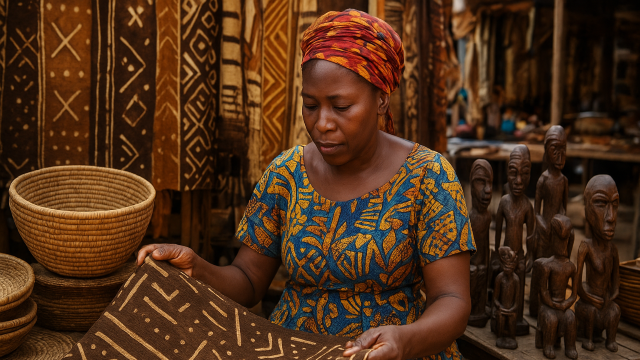In the crowded markets of Conakry, the capital of Guinea, tables overflow with baskets of woven grass, clay pots bearing delicate etchings, and textiles dyed in earthen hues. These objects, while serving practical purposes, also trace a line through the country’s artistic heritage, binding present-day makers to centuries of tradition.
Among the most distinctive of these creations is the bogolanfini, or mud cloth, whose roots lie with the Bambara people. Strips of handwoven cotton are coated with a fermented mud dye, then adorned with bold geometric symbols. Each motif carries meaning—representations of community values, moral lessons, or spiritual beliefs. Beyond its striking visual impact, the fabric functions as a medium of storytelling, every design linking individual artisans to their cultural lineage.
Equally emblematic are the wood carvings found across the country. Guinean craftsmen are adept at coaxing intricate forms from native hardwoods, producing masks and statues that hold ceremonial weight. These pieces are more than decorative objects; they emerge in dances, rituals, and social gatherings, reflecting both communal identities and the enduring reverence for ancestral traditions. The carvings, whether minimalist or elaborately detailed, stand as physical expressions of belief and continuity.
Basket weaving provides another thread in this fabric of cultural expression. In villages and towns, artisans deftly intertwine grasses or straw into vessels that are at once utilitarian and ornamental. Patterns vary from region to region, and the designs often carry a maker’s personal imprint. Though born from daily necessity, each basket reveals a quiet artistry that elevates the commonplace.
Pottery, too, remains central to Guinean craft. Clay drawn from local soils is shaped into vessels for cooking, storage, or ceremonial use. Methods of molding and firing differ by community, and the resulting pots often bear distinct stylistic markers of their origins. These pieces, with their blend of functionality and form, embody a continuity of practice that resists the erosion of time.
In artisan workshops and open-air markets, these crafts persist not as static relics but as evolving traditions. Young makers adapt techniques learned from elders, finding ways to sustain their livelihoods while keeping cultural memory alive. What emerges is less a museum of objects than a living archive—one where every woven strand, carved line, and dyed pattern echoes the persistence of creativity in Guinea.
Selected Sources
- Brett-Smith, Sarah C. The Making of Bamana Mud Cloth. Smithsonian Institution Press, 1994.
- Lamp, Frederick. See the Music, Hear the Dance: Rethinking African Art at the Baltimore Museum of Art. Prestel, 2004.
- McNaughton, Patrick R. The Mande Blacksmiths: Knowledge, Power, and Art in West Africa. Indiana University Press, 1988.
- Niane, Djibril Tamsir. Histoire des Mandingues de l’Ouest: Le royaume du Gabou. Présence Africaine, 1989.


